- Search Please fill out this field.
- Building Your Business
- Becoming an Owner
- Business Plans

How to Write the Financial Section of a Business Plan
Susan Ward wrote about small businesses for The Balance for 18 years. She has run an IT consulting firm and designed and presented courses on how to promote small businesses.
:max_bytes(150000):strip_icc():format(webp)/SusanWardLaptop2crop1-57aa62eb5f9b58974a12bac9.jpg)
Taking Stock of Expenses
The income statement, the cash flow projection, the balance sheet.
The financial section of your business plan determines whether or not your business idea is viable and will be the focus of any investors who may be attracted to your business idea. The financial section is composed of four financial statements: the income statement, the cash flow projection, the balance sheet, and the statement of shareholders' equity. It also should include a brief explanation and analysis of these four statements.
Think of your business expenses as two cost categories: your start-up expenses and your operating expenses. All the costs of getting your business up and running should be considered start-up expenses. These may include:
- Business registration fees
- Business licensing and permits
- Starting inventory
- Rent deposits
- Down payments on a property
- Down payments on equipment
- Utility setup fees
Your own list will expand as soon as you start to itemize them.
Operating expenses are the costs of keeping your business running . Think of these as your monthly expenses. Your list of operating expenses may include:
- Salaries (including your own)
- Rent or mortgage payments
- Telecommunication expenses
- Raw materials
- Distribution
- Loan payments
- Office supplies
- Maintenance
Once you have listed all of your operating expenses, the total will reflect the monthly cost of operating your business. Multiply this number by six, and you have a six-month estimate of your operating expenses. Adding this amount to your total startup expenses list, and you have a ballpark figure for your complete start-up costs.
Now you can begin to put together your financial statements for your business plan starting with the income statement.
The income statement shows your revenues, expenses, and profit for a particular period—a snapshot of your business that shows whether or not your business is profitable. Subtract expenses from your revenue to determine your profit or loss.
While established businesses normally produce an income statement each fiscal quarter or once each fiscal year, for the purposes of the business plan, an income statement should be generated monthly for the first year.
Not all of the categories in this income statement will apply to your business. Eliminate those that do not apply, and add categories where necessary to adapt this template to your business.
If you have a product-based business, the revenue section of the income statement will look different. Revenue will be called sales, and you should account for any inventory.
The cash flow projection shows how cash is expected to flow in and out of your business. It is an important tool for cash flow management because it indicates when your expenditures are too high or if you might need a short-term investment to deal with a cash flow surplus. As part of your business plan, the cash flow projection will show how much capital investment your business idea needs.
For investors, the cash flow projection shows whether your business is a good credit risk and if there is enough cash on hand to make your business a good candidate for a line of credit, a short-term loan , or a longer-term investment. You should include cash flow projections for each month over one year in the financial section of your business plan.
Do not confuse the cash flow projection with the cash flow statement. The cash flow statement shows the flow of cash in and out of your business. In other words, it describes the cash flow that has occurred in the past. The cash flow projection shows the cash that is anticipated to be generated or expended over a chosen period in the future.
There are three parts to the cash flow projection:
- Cash revenues: Enter your estimated sales figures for each month. Only enter the sales that are collectible in cash during each month you are detailing.
- Cash disbursements: Take the various expense categories from your ledger and list the cash expenditures you actually expect to pay for each month.
- Reconciliation of cash revenues to cash disbursements: This section shows an opening balance, which is the carryover from the previous month's operations. The current month's revenues are added to this balance, the current month's disbursements are subtracted, and the adjusted cash flow balance is carried over to the next month.
The balance sheet reports your business's net worth at a particular point in time. It summarizes all the financial data about your business in three categories:
- Assets: Tangible objects of financial value that are owned by the company.
- Liabilities: Debt owed to a creditor of the company.
- Equity: The net difference when the total liabilities are subtracted from the total assets .
The relationship between these elements of financial data is expressed with the equation: Assets = Liabilities + Equity .
For your business plan , you should create a pro forma balance sheet that summarizes the information in the income statement and cash flow projections. A business typically prepares a balance sheet once a year.
Once your balance sheet is complete, write a brief analysis for each of the three financial statements. The analysis should be short with highlights rather than an in-depth analysis. The financial statements themselves should be placed in your business plan's appendices.
Related Articles
Call Us (877) 968-7147 Login
Most popular blog categories
- Payroll Tips
- Accounting Tips
- Accountant Professional Tips

How to Craft the Financial Section of Business Plan (Hint: It’s All About the Numbers)
Writing a small business plan takes time and effort … especially when you have to dive into the numbers for the financial section. But, working on the financial section of business plan could lead to a big payoff for your business.
Read on to learn what is the financial section of a business plan, why it matters, and how to write one for your company.
What is the financial section of business plan?
Generally, the financial section is one of the last sections in a business plan. It describes a business’s historical financial state (if applicable) and future financial projections. Businesses include supporting documents such as budgets and financial statements, as well as funding requests in this section of the plan.
The financial part of the business plan introduces numbers. It comes after the executive summary, company description , market analysis, organization structure, product information, and marketing and sales strategies.
Businesses that are trying to get financing from lenders or investors use the financial section to make their case. This section also acts as a financial roadmap so you can budget for your business’s future income and expenses.
Why it matters
The financial section of the business plan is critical for moving beyond wordy aspirations and into hard data and the wonderful world of numbers.
Through the financial section, you can:
- Forecast your business’s future finances
- Budget for expenses (e.g., startup costs)
- Get financing from lenders or investors
- Grow your business

- Growth : 64% of businesses with a business plan were able to grow their business, compared to 43% of businesses without a business plan.
- Financing : 36% of businesses with a business plan secured a loan, compared to 18% of businesses without a plan.
So, if you want to possibly double your chances of securing a business loan, consider putting in a little time and effort into your business plan’s financial section.
Writing your financial section
To write the financial section, you first need to gather some information. Keep in mind that the information you gather depends on whether you have historical financial information or if you’re a brand-new startup.
Your financial section should detail:
- Business expenses
Financial projections
Financial statements, break-even point, funding requests, exit strategy, business expenses.
Whether you’ve been in business for one day or 10 years, you have expenses. These expenses might simply be startup costs for new businesses or fixed and variable costs for veteran businesses.
Take a look at some common business expenses you may need to include in the financial section of business plan:
- Licenses and permits
- Cost of goods sold
- Rent or mortgage payments
- Payroll costs (e.g., salaries and taxes)
- Utilities
- Equipment
- Supplies
- Advertising
Write down each type of expense and amount you currently have as well as expenses you predict you’ll have. Use a consistent time period (e.g., monthly costs).
Indicate which expenses are fixed (unchanging month-to-month) and which are variable (subject to changes).
How much do you anticipate earning from sales each month?
If you operate an existing business, you can look at previous monthly revenue to make an educated estimate. Take factors into consideration, like seasonality and economic ups and downs, when basing projections on previous cash flow.
Coming up with your financial projections may be a bit trickier if you are a startup. After all, you have nothing to go off of. Come up with a reasonable monthly goal based on things like your industry, competitors, and the market. Hint : Look at your market analysis section of the business plan for guidance.
A financial statement details your business’s finances. The three main types of financial statements are income statements, cash flow statements, and balance sheets.
Income statements summarize your business’s income and expenses during a period of time (e.g., a month). This document shows whether your business had a net profit or loss during that time period.
Cash flow statements break down your business’s incoming and outgoing money. This document details whether your company has enough cash on hand to cover expenses.
The balance sheet summarizes your business’s assets, liabilities, and equity. Balance sheets help with debt management and business growth decisions.
If you run a startup, you can create “pro forma financial statements,” which are statements based on projections.
If you’ve been in business for a bit, you should have financial statements in your records. You can include these in your business plan. And, include forecasted financial statements.

You’re just in luck. Check out our FREE guide, Use Financial Statements to Assess the Health of Your Business , to learn more about the different types of financial statements for your business.
Potential investors want to know when your business will reach its break-even point. The break-even point is when your business’s sales equal its expenses.
Estimate when your company will reach its break-even point and detail it in the financial section of business plan.
If you’re looking for financing, detail your funding request here. Include how much you are looking for, list ideal terms (e.g., 10-year loan or 15% equity), and how long your request will cover.
Remember to discuss why you are requesting money and what you plan on using the money for (e.g., equipment).
Back up your funding request by emphasizing your financial projections.
Last but not least, your financial section should also discuss your business’s exit strategy. An exit strategy is a plan that outlines what you’ll do if you need to sell or close your business, retire, etc.
Investors and lenders want to know how their investment or loan is protected if your business doesn’t make it. The exit strategy does just that. It explains how your business will make ends meet even if it doesn’t make it.
When you’re working on the financial section of business plan, take advantage of your accounting records to make things easier on yourself. For organized books, try Patriot’s online accounting software . Get your free trial now!
Stay up to date on the latest accounting tips and training
You may also be interested in:

Need help with accounting? Easy peasy.
Business owners love Patriot’s accounting software.
But don’t just take our word…

Explore the Demo! Start My Free Trial
Relax—run payroll in just 3 easy steps!
Get up and running with free payroll setup, and enjoy free expert support. Try our payroll software in a free, no-obligation 30-day trial.

Relax—pay employees in just 3 steps with Patriot Payroll!
Business owners love Patriot’s award-winning payroll software.

Watch Video Demo!
Watch Video Demo
- Website Examples
- Website Builder Comparisons
- Hosting Comparisons
- WooCommerce
- Everything Business
- HTTP Errors
- WordPress Errors
Financial Plan in Business Plan: Essential Steps for Success

Executive summary of a financial plan
Revenue streams and sales forecasts, expense breakdown and management, cash flow analysis, capital and funding requirements, budget allocation and financial controls, financial statements overview, profitability and net worth, market analysis and forecasting, liabilities and risk management, financial planning and performance metrics, exit strategy and long-term financial planning.
Creating a financial plan in a business plan is a crucial step that can determine the success or failure of your venture. Whether you’re looking to attract investors, secure loans, or simply ensure long-term growth, a well-crafted financial plan provides the roadmap. It not only showcases your current financial health but also forecasts the potential profitability of your business. This article will summarize the key components and steps to help you craft a comprehensive financial plan aligning with your overall business goals.
Understanding how to incorporate a financial plan into your business strategy can set you apart. By learning the essentials, you’ll be better equipped to manage cash flow, estimate profits, and navigate financial challenges.
What is a financial plan in business planning?
What are the elements of a financial plan?
How to write a financial plan in a business plan?
What should be included in a financial plan?
What is the financial part of the business plan?
How do I write a financial plan?
How to write a financial summary for a business plan?
What’s the difference between a business plan and a financial plan?

Create your online store in minutes!
Looking to sell online? Develop and launch your store with 10Web AI Ecommerce Website Builder.
What is a financial plan in a business plan?
A financial plan is a key part of a business plan . It shows the money side of a business idea. This plan helps owners and investors see if the business can make money.

A financial plan has several important parts. It starts with a sales forecast that predicts how much money the business will make.
Next, it lists all the costs of running the business. This includes things like rent, supplies, and worker pay.
The plan also shows cash flow. This tells when money comes in and goes out of the business. It helps make sure there’s always enough cash to pay bills.
Profit and loss statements are another big piece. They show if the business is making or losing money over time.
The balance sheet lists what the business owns and owes.
Lastly, the plan may include goals for sales growth or profit. It might also have ways to reach these goals. All these parts work together to paint a clear money picture of the business.
Elements of a financial plan in a business plan
The elements of a financial plan in a business plan are essential to understanding your company’s financial health and future potential. They provide a detailed picture of revenue generation, cost management, and profitability.
A financial plan needs clear revenue projections. Sales forecasts help predict future income. This section examines how to make these forecasts and what numbers to include.
Sales forecasting methodology
Sales forecasts use past data and market trends. Start by looking at your sales history. Check for patterns in monthly or yearly sales. Then, factor in things that might change sales. This could be new products, more marketing, or changes in the market.
Use a simple model to start. Take last year’s sales and add expected growth.
As you get more data, you can make your model more complex. Some businesses forecast by product line. Others look at sales channels or customer types.
Remember to account for seasonal changes. Many businesses have busy and slow periods. Your forecast should reflect these ups and downs.
Projected sales numbers
Your sales projections should cover at least the next 12 months. Break this down by month. For years 2 and 3, you can use yearly totals.
Be realistic in your numbers. Aiming low and exceeding your goals is better than aiming too high.
Include unit sales and prices in your forecast. This helps you see if growth comes from selling more or raising prices. If you have multiple products, show sales for each one.
Here’s a simple example of a sales forecast table:
This table shows sales growth for two products over time. It’s a clear way to present your projected income.
A good expense breakdown helps businesses track and control costs. It shows where money goes and helps find ways to save.
Fixed and variable costs
Fixed costs stay the same each month. These include rent, insurance, and salaries.
Variable costs change based on sales or production. Examples are raw materials and shipping fees.
To manage fixed costs:
- Look for cheaper office space
- Negotiate better deals with suppliers
- Cut unneeded services
For variable costs:
- Buy in bulk for discounts
- Find more efficient ways to make products
- Use cheaper shipping methods when possible
Tracking both types of costs helps businesses plan better and save money.
Operational expenses analysis
This looks at the day-to-day costs of running a business. It includes things like:
- Office supplies
- Employee travel
To analyze these expenses:
- List all costs
- Group them by type
- Look at trends over time
- Compare to industry standards
This helps find areas to cut costs. For example, a business might see high utility bills and decide to use energy-saving light bulbs.
Regular expense reviews can lead to big savings. Even minor cuts in daily costs add up over time.
Cash flow analysis helps businesses track money coming in and going out. It shows if a company can pay its bills and invest in growth. This analysis uses cash flow statements and looks at investing and financing activities.
Cash flow statements
A cash flow statement shows how cash moves through a business. It has three parts: operations, investing, and financing.
The operations section shows money from sales and day-to-day activities. This part is key for seeing if the business makes enough to cover costs.
Cash flow statements also show changes in assets and debts. They help spot cash shortages before they happen.
Managers use these statements to plan for slow periods and growth.
Investing and financing activities
Investing activities involve buying or selling long-term assets. This includes things like equipment or property.
Financing activities show how a business raises and repays money.
Examples of financing activities are:
- Taking out loans
- Selling stock
- Paying dividends
These activities affect cash flow but aren’t part of regular operations. They’re important for growth and expansion. Businesses must balance investing in the future with having cash for daily needs.
Money is key for new businesses. You need to figure out how much cash you need and where to get it. This helps you start strong and grow.
Estimates for seed capital
Seed capital is the money to get your business going. You need to add up all your costs. Think about things like:
- Permits and licenses
Make a list of everything you’ll need to buy. Get price quotes when you can. Add some extra for surprise costs. This gives you a good guess at your total seed money needs.
Having enough cash for at least 6 months of expenses is smart. This helps if sales are slow at first.
Investor funding strategy
Once you know how much money you need, plan how to get it. You have a few choices:
- Use your own savings
- Ask family and friends
- Look for angel investors
- Try crowdfunding
- Apply for a business loan
Most new businesses use a mix of these. Your choice depends on how much cash you need and how fast your business might grow.
Make a strong pitch to investors. Show them why your business idea is great. Tell them how you’ll use their money and when they might see returns.
Be ready to give up some control of your business if you take investor money. Decide how much of your company you’re willing to sell.
A business plan needs a strong budget and financial controls. These help a company use its money wisely. Good budgets split cash between different parts of the business.
Budget allocation means giving money to each department. This is based on what the company wants to do. Some areas may get more money than others.
Here’s a simple example of how a small business might split its budget:
Financial controls are rules that keep spending in check. They make sure money is used as planned. This can include:
- Approval steps for big purchases
- Regular budget reviews
- Tracking of all income and spending
These controls help catch problems early. They also show where a company might save money.
Good budget allocation and controls lead to smart financial decisions. They help a business use its resources well. This can give the company an edge over others in its field.
Regular budget checks are key. They let a business change its plans if needed. This keeps the company on track to meet its goals.
Financial statements show a company’s money situation. They help business owners and investors see how well a company is doing. These statements include income, balance sheet, and profit and loss information.

Income statement details
The income statement shows how much money a company makes and spends. It lists sales, costs, and profits over a set time. This could be a month, quarter, or year.
The income statement starts with total sales. Then, it takes away costs like supplies and employee pay. What’s left is the profit.
Sales numbers come from what the company thinks it will sell. Expense numbers come from expected costs.
The difference between sales and expenses is gross profit. Take away other costs like taxes to get net profit. This final number tells if the company made or lost money.
Balance sheet insights
A balance sheet shows what a company owns and owes at a certain time. It has three main parts: assets, liabilities, and equity.
The company owns assets like cash, equipment, and buildings. Liabilities are what the company owes, like loans or bills. Equity is the money left over for owners if all debts are paid.
The balance sheet must always balance. This means assets must equal liabilities plus equity. If they don’t, there’s a mistake somewhere.
A strong balance sheet shows more assets than liabilities. This means the company can pay its bills and has room to grow.
Profit and loss statement analysis
The profit and loss statement (P&L) is like the income statement. It shows if a company made money over time.
The P&L starts with sales and takes away all costs. What’s left is the profit or loss.
This statement helps owners see where money comes from and where it goes.
The P&L can show trends over time. For example, it might show that sales go up in summer. Or it might show that some costs are too high.
A business financial plan shows how much money a company expects to make and keep. It also looks at the total value of the business.
Gross margin and net income projections
Gross margin is the money left after paying for materials and labor. It’s found by subtracting the cost of goods sold from total sales. A higher gross margin means the business is more profitable.
Net income is the profit after all expenses are paid. To project net income:
- Estimate sales for each month or quarter
- Subtract all costs and expenses
- Account for taxes
These numbers help owners see if the business will make money. They also show when cash might be tight.
Shareholder equity calculation
Shareholder equity is the company’s net worth. It’s what’s left after subtracting debts from assets. To calculate it:
- Add up all assets (cash, inventory, equipment)
- Subtract all liabilities (loans, bills to pay)
The result is shareholder equity. A growing net worth over time is a good sign. It means the business is becoming more valuable.
Investors look at this number to see how much their company share is worth. A strong net worth can help attract new investors or get loans.
Market analysis and forecasting help businesses understand their industry and plan for the future. These tools give key insights into competitors, trends, and financial projections.
Competitive market research
Businesses need to know who they’re up against. Market research looks at other companies selling similar products or services. This research covers things like:
- Competitor prices
- Product features
- Marketing strategies
- Market share
Understanding the competition helps a business find ways to stand out. It also shows gaps in the market that a company could fill.
Market research uses surveys, focus groups, and data analysis. These methods give a clear picture of what customers want and how much they’ll pay.
Trends affecting financial projections
Economic shifts and industry changes impact a company’s financial future. Some key trends to watch are:
- New technologies
- Consumer behavior changes
- Government regulations
- Economic growth or recession
These trends shape financial forecasts. For example, a new law might increase costs. Or a tech breakthrough could boost sales.
Financial forecasting uses past data and future predictions. It creates estimates for:
- Sales revenue
Good forecasts help with budgeting and planning. They also show potential investors what to expect.
A financial plan needs to address both liabilities and risks. Liabilities are what a business owes to others. Common liabilities include:
- Credit card balances
- Accounts payable
Tracking liabilities helps businesses understand their true financial position. It’s important to list all debts and when they’re due.
Risk management aims to protect a business from financial losses. Some key risks are:
- Economic downturns
- Property damage
- Data breaches
To manage risks, businesses can:
- Get insurance
- Create emergency funds
- Diversify income streams
- Have backup suppliers
A good risk management plan looks at what could go wrong and how to respond. It helps keep a business stable when facing challenges.
Businesses should review their liabilities and risks regularly. This allows them to spot issues early and make changes as needed. With careful planning, companies can reduce their financial risks and build a stronger future.
Financial planning and performance metrics are key tools for businesses to track their financial health and progress. They provide valuable insights into a company’s efficiency, profitability, and overall financial position.
Key financial ratios
Financial ratios help analyze different aspects of a business’s finances. The debt-to-equity ratio shows how much a company relies on debt versus equity funding. A lower ratio is often seen as better. The current ratio measures a firm’s ability to pay short-term debts. A ratio above 1 is good.
Profit margin is the percentage of sales that turn into profit. A higher margin means more efficient operations. Return on assets (ROA) shows how well a company uses its assets to generate profit. A higher ROA is better.
The inventory turnover ratio reveals how quickly a business sells its inventory. A higher ratio may indicate strong sales or good inventory management.
Performance benchmarking
Benchmarking compares a company’s performance to industry standards or competitors. It helps identify areas for improvement and set realistic goals.
The revenue growth rate is a key benchmark. It shows how fast a company expands compared to others in its industry. Gross profit margin compares a firm’s pricing and production costs to peers.
Market share is another important metric. It reveals a company’s position relative to competitors. Customer acquisition cost and retention rate are vital for assessing marketing effectiveness and customer satisfaction.
Employee productivity metrics, such as revenue per employee, can highlight operational efficiency compared to industry norms.
A business exit strategy is a plan for selling or leaving a company. It helps owners prepare for the future.
Exit plans are part of long-term financial planning.
There are several types of exit strategies:
- Selling to a buyer
- Passing the business to family
- Going public with an IPO
- Merging with another company
- Closing the business
Owners should think about their goals when choosing an exit strategy. Some may want to keep the business in the family. Others might prefer to sell for the highest price.
Exit planning takes time. Experts say to start 3-5 years before leaving.
This gives time to boost the company’s value. It also allows for finding the right buyers or successors.
A good exit plan includes:
- Business valuation
- Financial records
- List of assets
- Growth plans
- Potential buyers
Long-term financial planning helps with exit strategies. It involves setting goals and making plans to reach them.
This might include saving money, investing, or growing the business.
Regular financial check-ups are important. They help track progress toward exit goals.
Owners should review their plans yearly and adjust as needed.
A solid financial plan in your business plan is not just about crunching numbers— it’s about creating a clear path toward growth and stability.
Every component plays a role in guiding your business toward profitability, from financial statements to cash flow projections. Whether seeking funding or simply aiming to understand your finances better, a well-thought-out financial plan is indispensable.
Develop and launch your store with 10Web AI Ecommerce Website Builder.

Short Term Goals for a Business: Driving Success in the Next Quarter
Short-term goals help businesses stay on track and make progress. These goals focus on what a company wants to achieve in the near future, usually within a few weeks or months. Setting clear short-term goals gives your business direction and helps you measure success. Short-term goals can cover many areas of a business. They may relate to sales, customer service,…
How to Start a Business in Rhode Island: A Guide for Entrepreneurs
How to start a business in oklahoma: a guide for beginners, how to start a business in new hampshire: a guide to success, how to start a business in nevada: your guide to success, how to start a business in wyoming: a guide to your new venture, leave a comment cancel reply.
Your email address will not be published. Required fields are marked *
Your email address will never be published or shared. Required fields are marked *
Email address *
Save my name, email, and website in this browser for the next time I comment.
Get a head start on website creation with AI
Create a custom website tailored to your business needs 10X faster with 10Web AI Website Builder!
Free Financial Templates for a Business Plan
By Andy Marker | July 29, 2020
- Share on Facebook
- Share on LinkedIn
Link copied
In this article, we’ve rounded up expert-tested financial templates for your business plan, all of which are free to download in Excel, Google Sheets, and PDF formats.
Included on this page, you’ll find the essential financial statement templates, including income statement templates , cash flow statement templates , and balance sheet templates . Plus, we cover the key elements of the financial section of a business plan .
Financial Plan Templates
Download and prepare these financial plan templates to include in your business plan. Use historical data and future projections to produce an overview of the financial health of your organization to support your business plan and gain buy-in from stakeholders
Business Financial Plan Template
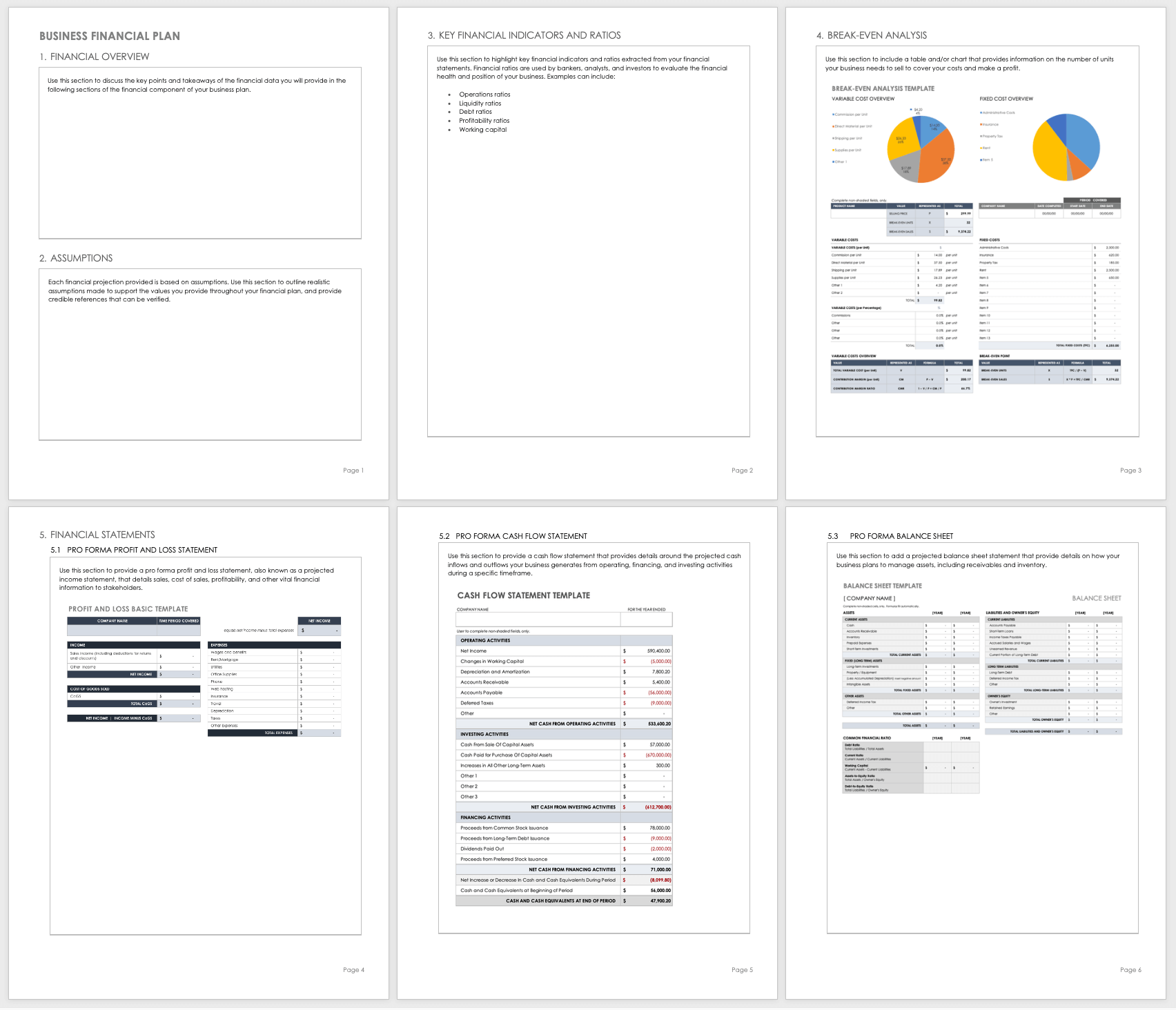
Use this financial plan template to organize and prepare the financial section of your business plan. This customizable template has room to provide a financial overview, any important assumptions, key financial indicators and ratios, a break-even analysis, and pro forma financial statements to share key financial data with potential investors.
Download Financial Plan Template
Word | PDF | Smartsheet
Financial Plan Projections Template for Startups

This financial plan projections template comes as a set of pro forma templates designed to help startups. The template set includes a 12-month profit and loss statement, a balance sheet, and a cash flow statement for you to detail the current and projected financial position of a business.
Download Startup Financial Projections Template
Excel | Smartsheet
Income Statement Templates for Business Plan
Also called profit and loss statements , these income statement templates will empower you to make critical business decisions by providing insight into your company, as well as illustrating the projected profitability associated with business activities. The numbers prepared in your income statement directly influence the cash flow and balance sheet forecasts.
Pro Forma Income Statement/Profit and Loss Sample
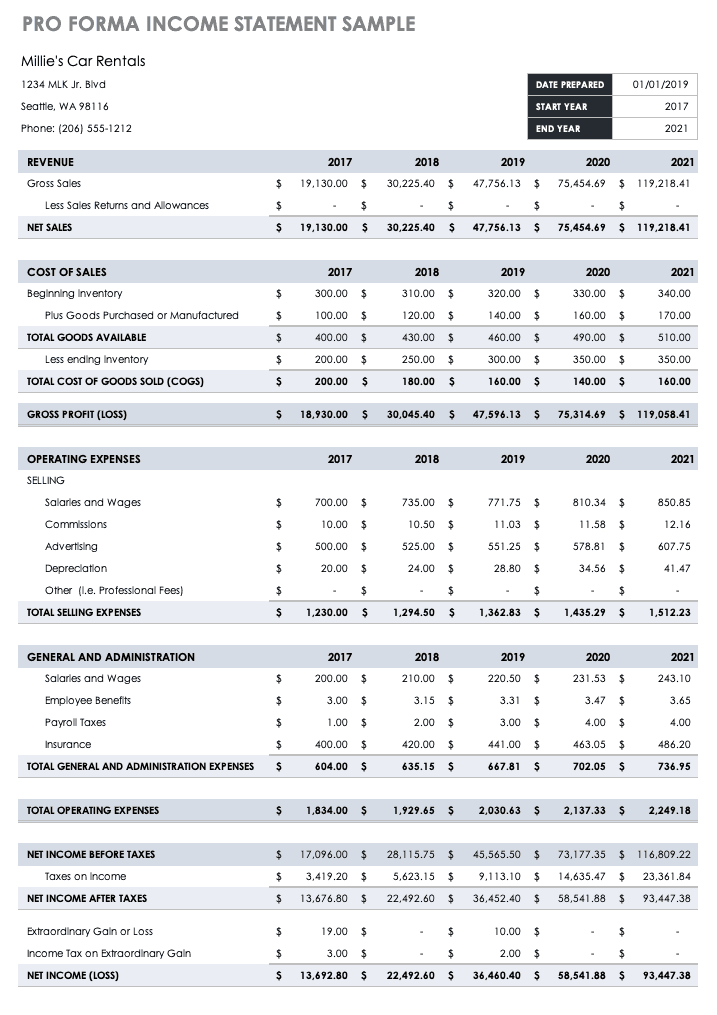
Use this pro forma income statement template to project income and expenses over a three-year time period. Pro forma income statements consider historical or market analysis data to calculate the estimated sales, cost of sales, profits, and more.
Download Pro Forma Income Statement Sample - Excel
Small Business Profit and Loss Statement
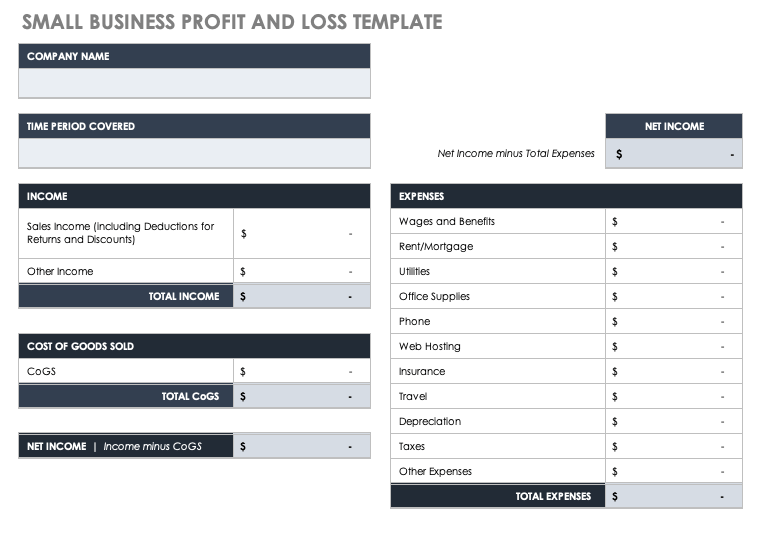
Small businesses can use this simple profit and loss statement template to project income and expenses for a specific time period. Enter expected income, cost of goods sold, and business expenses, and the built-in formulas will automatically calculate the net income.
Download Small Business Profit and Loss Template - Excel
3-Year Income Statement Template

Use this income statement template to calculate and assess the profit and loss generated by your business over three years. This template provides room to enter revenue and expenses associated with operating your business and allows you to track performance over time.
Download 3-Year Income Statement Template
For additional resources, including how to use profit and loss statements, visit “ Download Free Profit and Loss Templates .”
Cash Flow Statement Templates for Business Plan
Use these free cash flow statement templates to convey how efficiently your company manages the inflow and outflow of money. Use a cash flow statement to analyze the availability of liquid assets and your company’s ability to grow and sustain itself long term.
Simple Cash Flow Template

Use this basic cash flow template to compare your business cash flows against different time periods. Enter the beginning balance of cash on hand, and then detail itemized cash receipts, payments, costs of goods sold, and expenses. Once you enter those values, the built-in formulas will calculate total cash payments, net cash change, and the month ending cash position.
Download Simple Cash Flow Template
12-Month Cash Flow Forecast Template
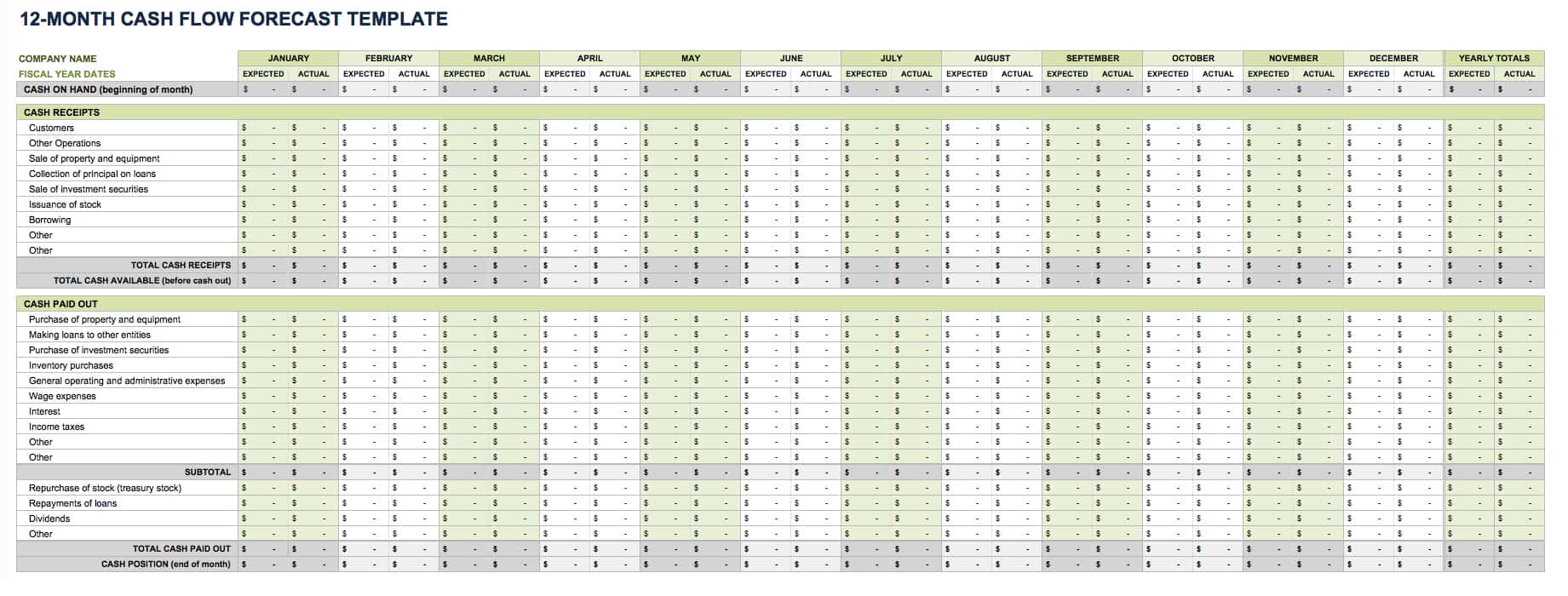
Use this cash flow forecast template, also called a pro forma cash flow template, to track and compare expected and actual cash flow outcomes on a monthly and yearly basis. Enter the cash on hand at the beginning of each month, and then add the cash receipts (from customers, issuance of stock, and other operations). Finally, add the cash paid out (purchases made, wage expenses, and other cash outflow). Once you enter those values, the built-in formulas will calculate your cash position for each month with.
Download 12-Month Cash Flow Forecast
3-Year Cash Flow Statement Template Set
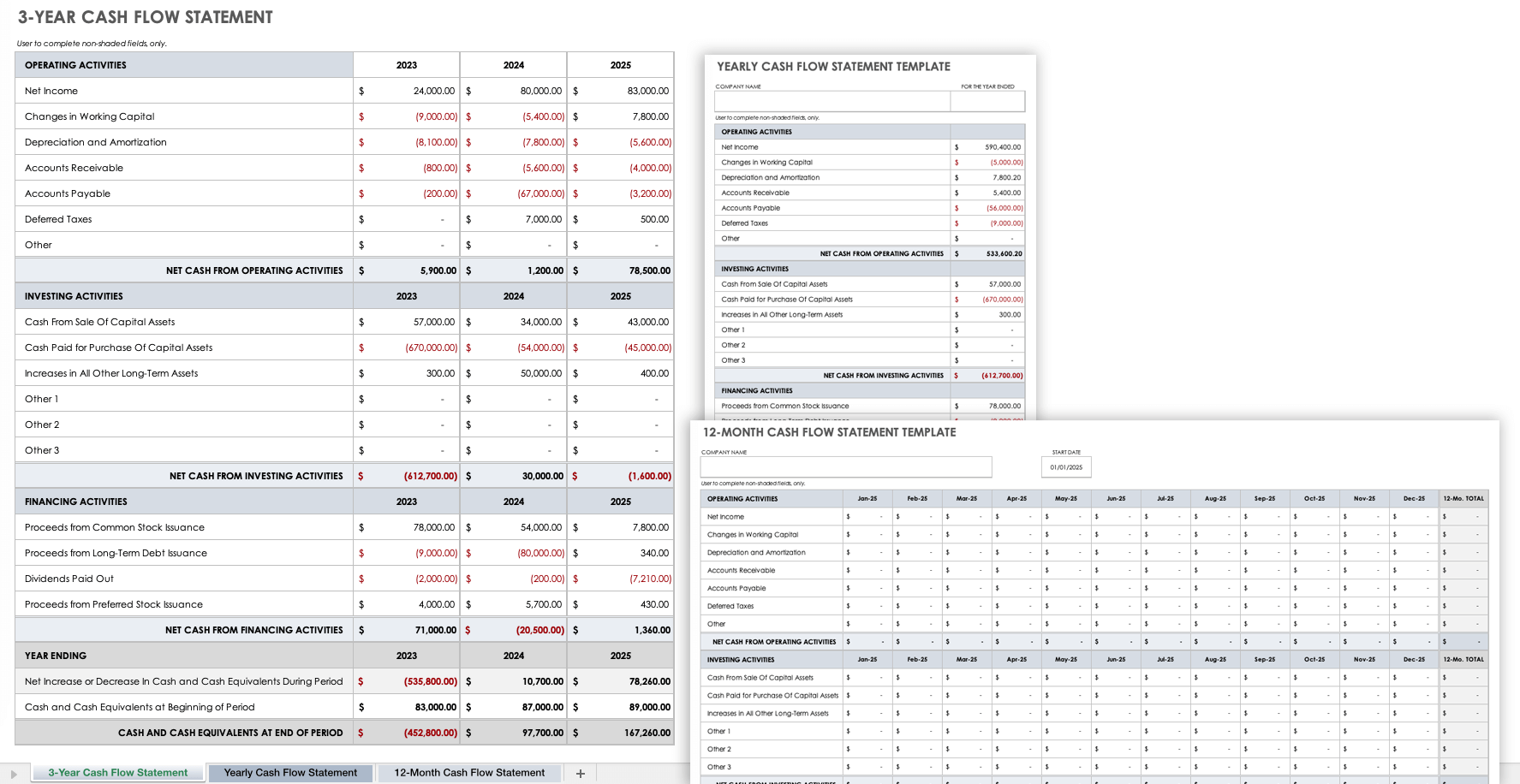
Use this cash flow statement template set to analyze the amount of cash your company has compared to its expenses and liabilities. This template set contains a tab to create a monthly cash flow statement, a yearly cash flow statement, and a three-year cash flow statement to track cash flow for the operating, investing, and financing activities of your business.
Download 3-Year Cash Flow Statement Template
For additional information on managing your cash flow, including how to create a cash flow forecast, visit “ Free Cash Flow Statement Templates .”
Balance Sheet Templates for a Business Plan
Use these free balance sheet templates to convey the financial position of your business during a specific time period to potential investors and stakeholders.
Small Business Pro Forma Balance Sheet
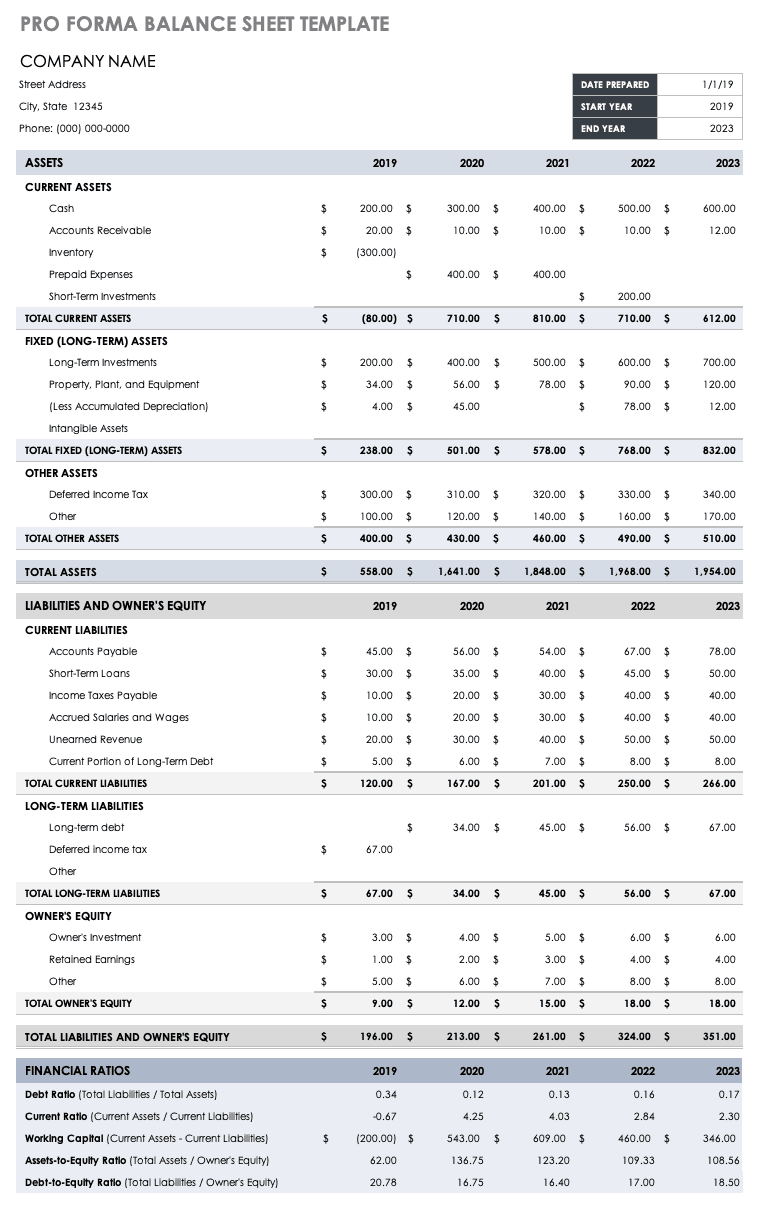
Small businesses can use this pro forma balance sheet template to project account balances for assets, liabilities, and equity for a designated period. Established businesses can use this template (and its built-in formulas) to calculate key financial ratios, including working capital.
Download Pro Forma Balance Sheet Template
Monthly and Quarterly Balance Sheet Template
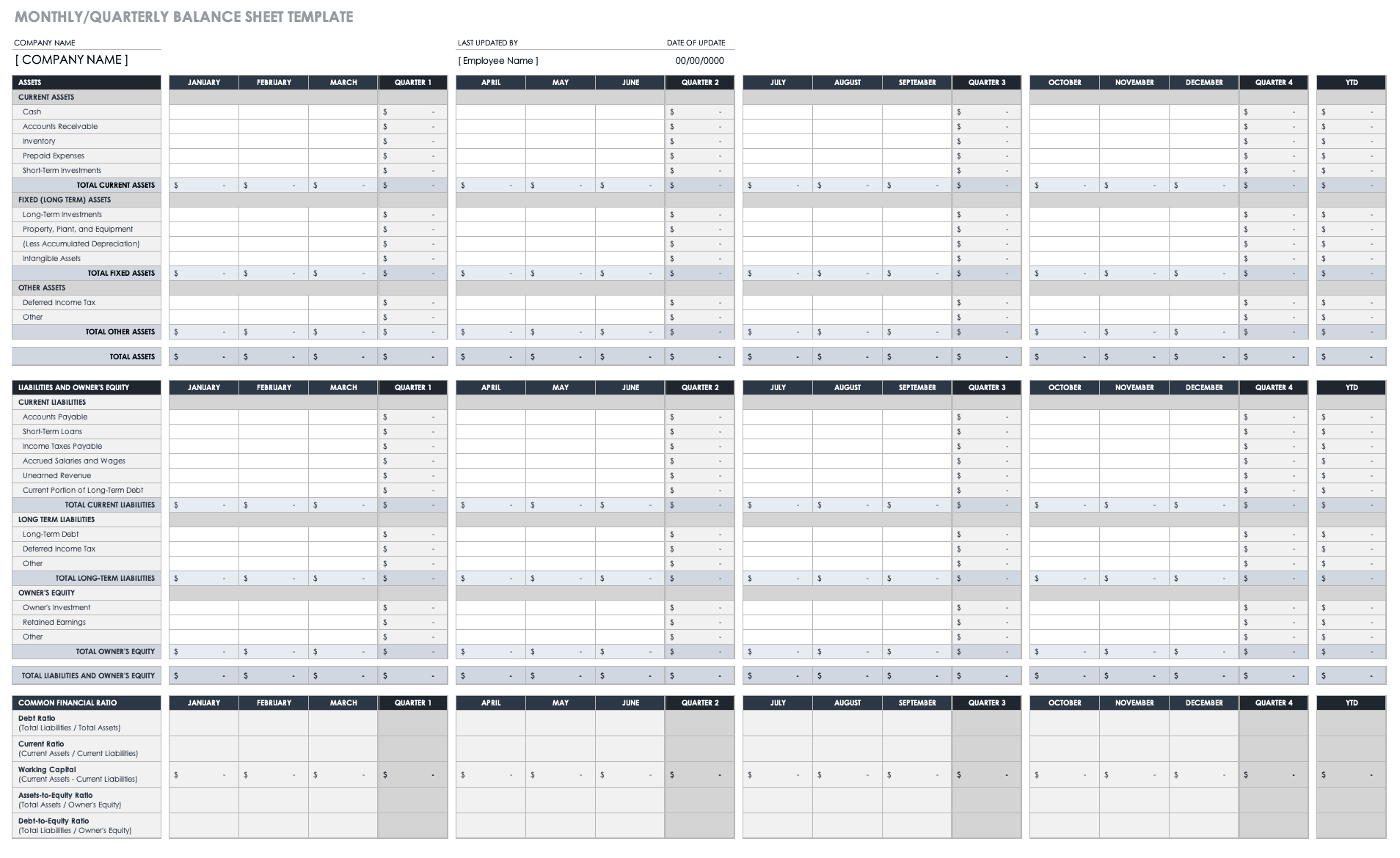
Use this balance sheet template to evaluate your company’s financial health on a monthly, quarterly, and annual basis. You can also use this template to project your financial position for a specified time in the future. Once you complete the balance sheet, you can compare and analyze your assets, liabilities, and equity on a quarter-over-quarter or year-over-year basis.
Download Monthly/Quarterly Balance Sheet Template - Excel
Yearly Balance Sheet Template

Use this balance sheet template to compare your company’s short and long-term assets, liabilities, and equity year-over-year. This template also provides calculations for common financial ratios with built-in formulas, so you can use it to evaluate account balances annually.
Download Yearly Balance Sheet Template - Excel
For more downloadable resources for a wide range of organizations, visit “ Free Balance Sheet Templates .”
Sales Forecast Templates for Business Plan
Sales projections are a fundamental part of a business plan, and should support all other components of your plan, including your market analysis, product offerings, and marketing plan . Use these sales forecast templates to estimate future sales, and ensure the numbers align with the sales numbers provided in your income statement.
Basic Sales Forecast Sample Template

Use this basic forecast template to project the sales of a specific product. Gather historical and industry sales data to generate monthly and yearly estimates of the number of units sold and the price per unit. Then, the pre-built formulas will calculate percentages automatically. You’ll also find details about which months provide the highest sales percentage, and the percentage change in sales month-over-month.
Download Basic Sales Forecast Sample Template
12-Month Sales Forecast Template for Multiple Products

Use this sales forecast template to project the future sales of a business across multiple products or services over the course of a year. Enter your estimated monthly sales, and the built-in formulas will calculate annual totals. There is also space to record and track year-over-year sales, so you can pinpoint sales trends.
Download 12-Month Sales Forecasting Template for Multiple Products
3-Year Sales Forecast Template for Multiple Products
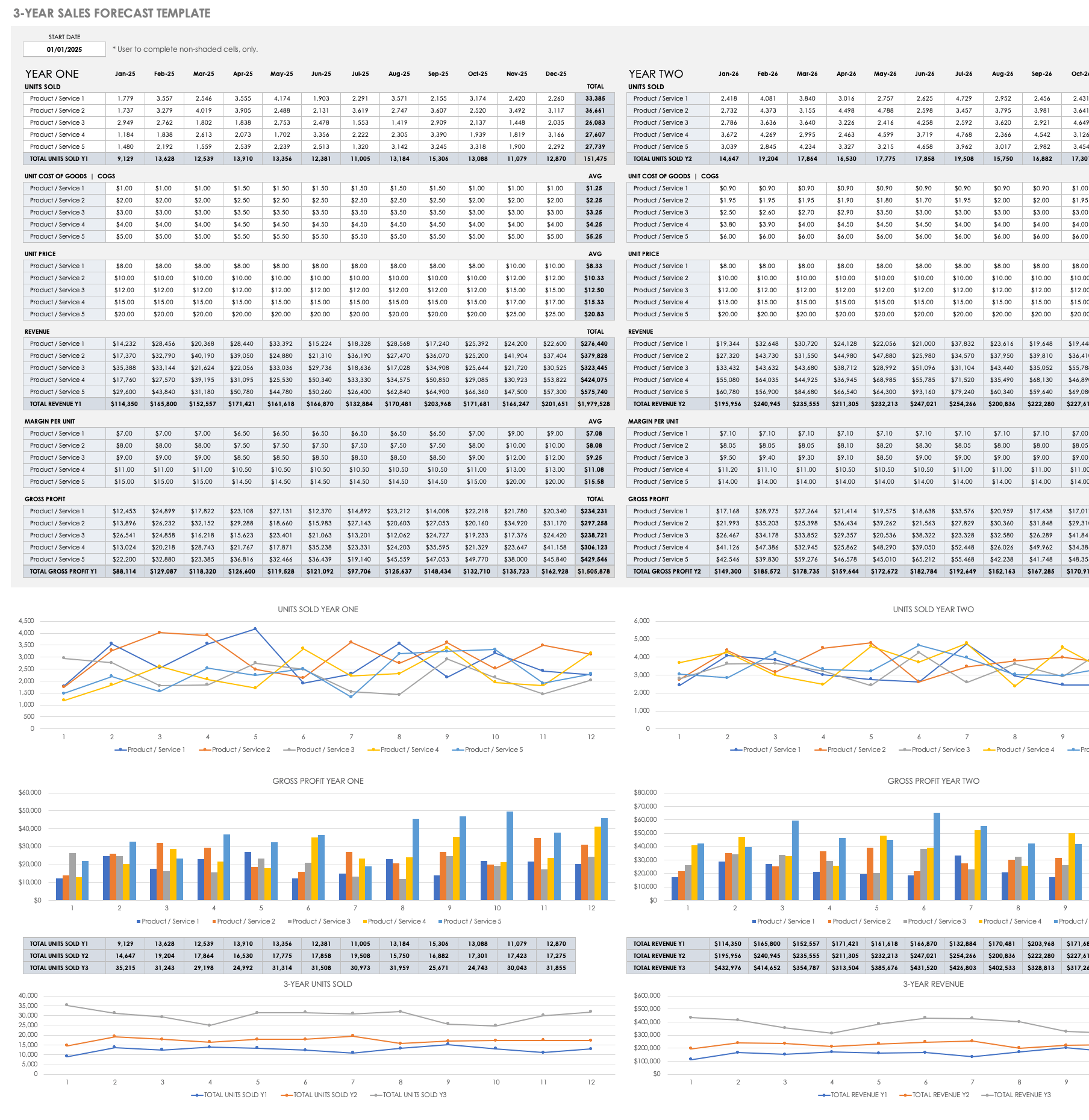
Use this sales forecast template to estimate the monthly and yearly sales for multiple products over a three-year period. Enter the monthly units sold, unit costs, and unit price. Once you enter those values, built-in formulas will automatically calculate revenue, margin per unit, and gross profit. This template also provides bar charts and line graphs to visually display sales and gross profit year over year.
Download 3-Year Sales Forecast Template - Excel
For a wider selection of resources to project your sales, visit “ Free Sales Forecasting Templates .”
Break-Even Analysis Template for Business Plan
A break-even analysis will help you ascertain the point at which a business, product, or service will become profitable. This analysis uses a calculation to pinpoint the number of service or unit sales you need to make to cover costs and make a profit.
Break-Even Analysis Template

Use this break-even analysis template to calculate the number of sales needed to become profitable. Enter the product's selling price at the top of the template, and then add the fixed and variable costs. Once you enter those values, the built-in formulas will calculate the total variable cost, the contribution margin, and break-even units and sales values.
Download Break-Even Analysis Template
For additional resources, visit, “ Free Financial Planning Templates .”
Business Budget Templates for Business Plan
These business budget templates will help you track costs (e.g., fixed and variable) and expenses (e.g., one-time and recurring) associated with starting and running a business. Having a detailed budget enables you to make sound strategic decisions, and should align with the expense values listed on your income statement.
Startup Budget Template
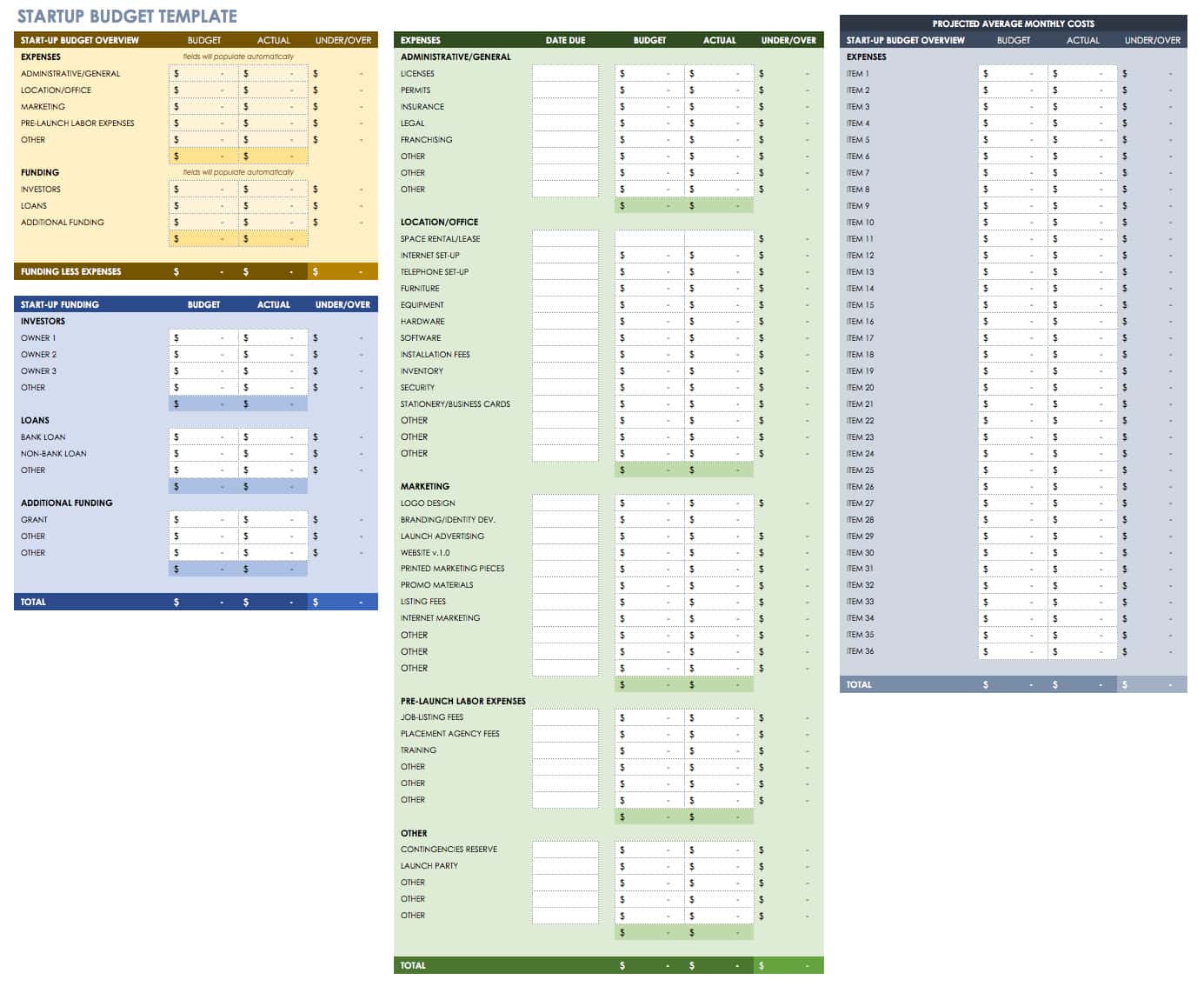
Use this startup budget template to track estimated and actual costs and expenses for various business categories, including administrative, marketing, labor, and other office costs. There is also room to provide funding estimates from investors, banks, and other sources to get a detailed view of the resources you need to start and operate your business.
Download Startup Budget Template
Small Business Budget Template
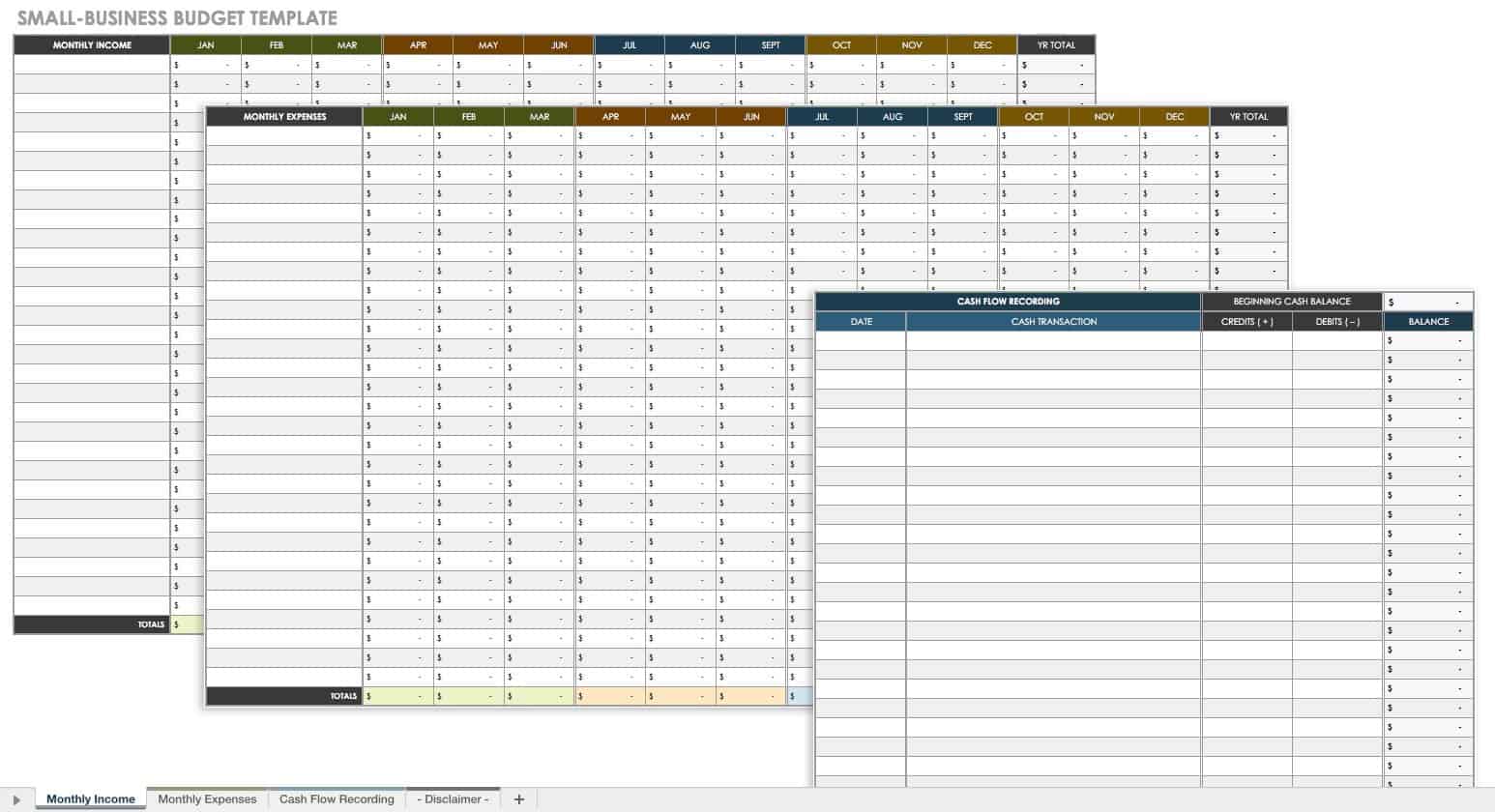
This business budget template is ideal for small businesses that want to record estimated revenue and expenditures on a monthly and yearly basis. This customizable template comes with a tab to list income, expenses, and a cash flow recording to track cash transactions and balances.
Download Small Business Budget Template
Professional Business Budget Template

Established organizations will appreciate this customizable business budget template, which contains a separate tab to track projected business expenses, actual business expenses, variances, and an expense analysis. Once you enter projected and actual expenses, the built-in formulas will automatically calculate expense variances and populate the included visual charts.
Download Professional Business Budget Template
For additional resources to plan and track your business costs and expenses, visit “ Free Business Budget Templates for Any Company .”
Other Financial Templates for Business Plan
In this section, you’ll find additional financial templates that you may want to include as part of your larger business plan.
Startup Funding Requirements Template

This simple startup funding requirements template is useful for startups and small businesses that require funding to get business off the ground. The numbers generated in this template should align with those in your financial projections, and should detail the allocation of acquired capital to various startup expenses.
Download Startup Funding Requirements Template - Excel
Personnel Plan Template
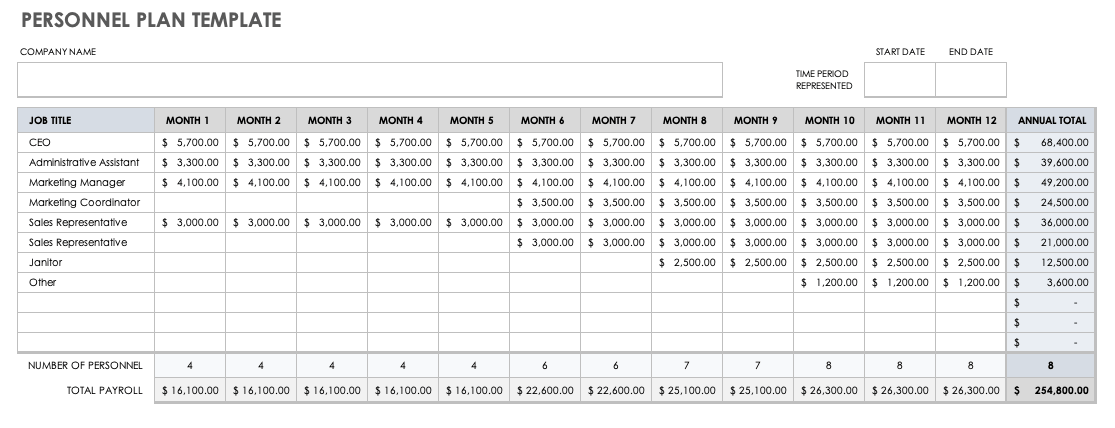
Use this customizable personnel plan template to map out the current and future staff needed to get — and keep — the business running. This information belongs in the personnel section of a business plan, and details the job title, amount of pay, and hiring timeline for each position. This template calculates the monthly and yearly expenses associated with each role using built-in formulas. Additionally, you can add an organizational chart to provide a visual overview of the company’s structure.
Download Personnel Plan Template - Excel
Elements of the Financial Section of a Business Plan
Whether your organization is a startup, a small business, or an enterprise, the financial plan is the cornerstone of any business plan. The financial section should demonstrate the feasibility and profitability of your idea and should support all other aspects of the business plan.
Below, you’ll find a quick overview of the components of a solid financial plan.
- Financial Overview: This section provides a brief summary of the financial section, and includes key takeaways of the financial statements. If you prefer, you can also add a brief description of each statement in the respective statement’s section.
- Key Assumptions: This component details the basis for your financial projections, including tax and interest rates, economic climate, and other critical, underlying factors.
- Break-Even Analysis: This calculation helps establish the selling price of a product or service, and determines when a product or service should become profitable.
- Pro Forma Income Statement: Also known as a profit and loss statement, this section details the sales, cost of sales, profitability, and other vital financial information to stakeholders.
- Pro Forma Cash Flow Statement: This area outlines the projected cash inflows and outflows the business expects to generate from operating, financing, and investing activities during a specific timeframe.
- Pro Forma Balance Sheet: This document conveys how your business plans to manage assets, including receivables and inventory.
- Key Financial Indicators and Ratios: In this section, highlight key financial indicators and ratios extracted from financial statements that bankers, analysts, and investors can use to evaluate the financial health and position of your business.
Need help putting together the rest of your business plan? Check out our free simple business plan templates to get started. You can learn how to write a successful simple business plan here .
Visit this free non-profit business plan template roundup or download a fill-in-the-blank business plan template to make things easy. If you are looking for a business plan template by file type, visit our pages dedicated specifically to Microsoft Excel , Microsoft Word , and Adobe PDF business plan templates. Read our articles offering startup business plan templates or free 30-60-90-day business plan templates to find more tailored options.
Discover a Better Way to Manage Business Plan Financials and Finance Operations
Empower your people to go above and beyond with a flexible platform designed to match the needs of your team — and adapt as those needs change.
The Smartsheet platform makes it easy to plan, capture, manage, and report on work from anywhere, helping your team be more effective and get more done. Report on key metrics and get real-time visibility into work as it happens with roll-up reports, dashboards, and automated workflows built to keep your team connected and informed.
When teams have clarity into the work getting done, there’s no telling how much more they can accomplish in the same amount of time. Try Smartsheet for free, today.
Discover why over 90% of Fortune 100 companies trust Smartsheet to get work done.
How to Prepare a Financial Plan for Startup Business (w/ example)

Financial Statements Template
Ajay Jagtap
- December 7, 2023
- 13 Min Read

If someone were to ask you about your business financials, could you give them a detailed answer?
Let’s say they ask—how do you allocate your operating expenses? What is your cash flow situation like? What is your exit strategy? And a series of similar other questions.
Instead of mumbling what to answer or shooting in the dark, as a founder, you must prepare yourself to answer this line of questioning—and creating a financial plan for your startup is the best way to do it.
A business plan’s financial plan section is no easy task—we get that.
But, you know what—this in-depth guide and financial plan example can make forecasting as simple as counting on your fingertips.
Ready to get started? Let’s begin by discussing startup financial planning.
What is Startup Financial Planning?
Startup financial planning, in simple terms, is a process of planning the financial aspects of a new business. It’s an integral part of a business plan and comprises its three major components: balance sheet, income statement, and cash-flow statement.
Apart from these statements, your financial section may also include revenue and sales forecasts, assets & liabilities, break-even analysis, and more. Your first financial plan may not be very detailed, but you can tweak and update it as your company grows.
Key Takeaways
- Realistic assumptions, thorough research, and a clear understanding of the market are the key to reliable financial projections.
- Cash flow projection, balance sheet, and income statement are three major components of a financial plan.
- Preparing a financial plan is easier and faster when you use a financial planning tool.
- Exploring “what-if” scenarios is an ideal method to understand the potential risks and opportunities involved in the business operations.
Why is Financial Planning Important to Your Startup?
Poor financial planning is one of the biggest reasons why most startups fail. In fact, a recent CNBC study reported that running out of cash was the reason behind 44% of startup failures in 2022.
A well-prepared financial plan provides a clear financial direction for your business, helps you set realistic financial objectives, create accurate forecasts, and shows your business is committed to its financial objectives.
It’s a key element of your business plan for winning potential investors. In fact, YC considered recent financial statements and projections to be critical elements of their Series A due diligence checklist .
Your financial plan demonstrates how your business manages expenses and generates revenue and helps them understand where your business stands today and in 5 years.
Makes sense why financial planning is important to your startup or small business, doesn’t it? Let’s cut to the chase and discuss the key components of a startup’s financial plan.
Say goodbye to old-school excel sheets & templates
Make accurate financial plan faster with AI
Plans starting from $7/month


Key Components of a Startup Financial Plan
Whether creating a financial plan from scratch for a business venture or just modifying it for an existing one, here are the key components to consider including in your startup’s financial planning process.
Income Statement
An Income statement , also known as a profit-and-loss statement(P&L), shows your company’s income and expenditures. It also demonstrates how your business experienced any profit or loss over a given time.
Consider it as a snapshot of your business that shows the feasibility of your business idea. An income statement can be generated considering three scenarios: worst, expected, and best.
Your income or P&L statement must list the following:
- Cost of goods or cost of sale
- Gross margin
- Operating expenses
- Revenue streams
- EBITDA (Earnings before interest, tax, depreciation , & amortization )
Established businesses can prepare annual income statements, whereas new businesses and startups should consider preparing monthly statements.
Cash flow Statement
A cash flow statement is one of the most critical financial statements for startups that summarize your business’s cash in-and-out flows over a given time.
This section provides details on the cash position of your business and its ability to meet monetary commitments on a timely basis.
Your cash flow projection consists of the following three components:
✅ Cash revenue projection: Here, you must enter each month’s estimated or expected sales figures.
✅ Cash disbursements: List expenditures that you expect to pay in cash for each month over one year.
✅ Cash flow reconciliation: Cash flow reconciliation is a process used to ensure the accuracy of cash flow projections. The adjusted amount is the cash flow balance carried over to the next month.
Furthermore, a company’s cash flow projections can be crucial while assessing liquidity, its ability to generate positive cash flows and pay off debts, and invest in growth initiatives.
Balance Sheet
Your balance sheet is a financial statement that reports your company’s assets, liabilities, and shareholder equity at a given time.
Consider it as a snapshot of what your business owns and owes, as well as the amount invested by the shareholders.
This statement consists of three parts: assets , liabilities, and the balance calculated by the difference between the first two. The final numbers on this sheet reflect the business owner’s equity or value.
Balance sheets follow the following accounting equation with assets on one side and liabilities plus Owner’s equity on the other:
Here is what’s the core purpose of having a balance-sheet:
- Indicates the capital need of the business
- It helps to identify the allocation of resources
- It calculates the requirement of seed money you put up, and
- How much finance is required?
Since it helps investors understand the condition of your business on a given date, it’s a financial statement you can’t miss out on.
Break-even Analysis
Break-even analysis is a startup or small business accounting practice used to determine when a company, product, or service will become profitable.
For instance, a break-even analysis could help you understand how many candles you need to sell to cover your warehousing and manufacturing costs and start making profits.
Remember, anything you sell beyond the break-even point will result in profit.
You must be aware of your fixed and variable costs to accurately determine your startup’s break-even point.
- Fixed costs: fixed expenses that stay the same no matter what.
- Variable costs: expenses that fluctuate over time depending on production or sales.
A break-even point helps you smartly price your goods or services, cover fixed costs, catch missing expenses, and set sales targets while helping investors gain confidence in your business. No brainer—why it’s a key component of your startup’s financial plan.
Having covered all the key elements of a financial plan, let’s discuss how you can create a financial plan for your startup or small business.
How to Create a Financial Section of a Startup Business Plan?
1. determine your financial needs.
You can’t start financial planning without understanding your financial requirements, can you? Get your notepad or simply open a notion doc; it’s time for some critical thinking.
Start by assessing your current situation by—calculating your income, expenses , assets, and liabilities, what the startup costs are, how much you have against them, and how much financing you need.
Assessing your current financial situation and health will help determine how much capital you need for your small business and help plan fundraising activities and outreach.
Furthermore, determining financial needs helps prioritize operational activities and expenses, effectively allocate resources, and increase the viability and sustainability of a business in the long run.
Having learned to determine financial needs, let’s head straight to setting financial goals.
2. Define Your Financial Goals
Setting realistic financial goals is fundamental in preparing an effective financial plan for your business plan. So, it would help to outline your long-term strategies and goals at the beginning of your financial planning process.
Let’s understand it this way—if you are a SaaS startup pursuing VC financing rounds, you may ask investors about what matters to them the most and prepare your financial plan accordingly.
However, a coffee shop owner seeking a business loan may need to create a plan that appeals to banks, not investors. At the same time, an internal financial plan designed to offer financial direction and resource allocation may not be the same as previous examples, seeing its different use case.
Feeling overwhelmed? Just define your financial goals—you’ll be fine.
You can start by identifying your business KPIs (key performance indicators); it would be an ideal starting point.
3. Choose the Right Financial Planning Tool
Let’s face it—preparing a financial plan using Excel is no joke. One would only use this method if they had all the time in the world.
Having the right financial planning software will simplify and speed up the process and guide you through creating accurate financial forecasts.
Many financial planning software and tools claim to be the ideal solution, but it’s you who will identify and choose a tool that is best for your financial planning needs.

Create a Financial Plan with Upmetrics in no time
Enter your Financial Assumptions, and we’ll calculate your monthly/quarterly and yearly financial projections.

Start Forecasting
4. Make Assumptions Before Projecting Financials
Once you have a financial planning tool, you can move forward to the next step— making financial assumptions for your plan based on your company’s current performance and past financial records.
You’re just making predictions about your company’s financial future, so there’s no need to overthink or complicate the process.
You can gather your business’ historical financial data, market trends, and other relevant documents to help create a base for accurate financial projections.
After you have developed rough assumptions and a good understanding of your business finances, you can move forward to the next step—projecting financials.
5. Prepare Realistic Financial Projections
It’s a no-brainer—financial forecasting is the most critical yet challenging aspect of financial planning. However, it’s effortless if you’re using a financial planning software.
Upmetrics’ forecasting feature can help you project financials for up to 7 years. However, new startups usually consider planning for the next five years. Although it can be contradictory considering your financial goals and investor specifications.
Following are the two key aspects of your financial projections:
Revenue Projections
In simple terms, revenue projections help investors determine how much revenue your business plans to generate in years to come.
It generally involves conducting market research, determining pricing strategy , and cash flow analysis—which we’ve already discussed in the previous steps.
The following are the key components of an accurate revenue projection report:
- Market analysis
- Sales forecast
- Pricing strategy
- Growth assumptions
- Seasonal variations
This is a critical section for pre-revenue startups, so ensure your projections accurately align with your startup’s financial model and revenue goals.
Expense Projections
Both revenue and expense projections are correlated to each other. As revenue forecasts projected revenue assumptions, expense projections will estimate expenses associated with operating your business.
Accurately estimating your expenses will help in effective cash flow analysis and proper resource allocation.
These are the most common costs to consider while projecting expenses:
- Fixed costs
- Variable costs
- Employee costs or payroll expenses
- Operational expenses
- Marketing and advertising expenses
- Emergency fund
Remember, realistic assumptions, thorough research, and a clear understanding of your market are the key to reliable financial projections.
6. Consider “What if” Scenarios
After you project your financials, it’s time to test your assumptions with what-if analysis, also known as sensitivity analysis.
Using what-if analysis with different scenarios while projecting your financials will increase transparency and help investors better understand your startup’s future with its best, expected, and worst-case scenarios.
Exploring “what-if” scenarios is the best way to better understand the potential risks and opportunities involved in business operations. This proactive exercise will help you make strategic decisions and necessary adjustments to your financial plan.
7. Build a Visual Report
If you’ve closely followed the steps leading to this, you know how to research for financial projections, create a financial plan, and test assumptions using “what-if” scenarios.
Now, we’ll prepare visual reports to present your numbers in a visually appealing and easily digestible format.
Don’t worry—it’s no extra effort. You’ve already made a visual report while creating your financial plan and forecasting financials.
Check the dashboard to see the visual presentation of your projections and reports, and use the necessary financial data, diagrams, and graphs in the final draft of your financial plan.
Here’s what Upmetrics’ dashboard looks like:

8. Monitor and Adjust Your Financial Plan
Even though it’s not a primary step in creating a good financial plan for your small business, it’s quite essential to regularly monitor and adjust your financial plan to ensure the assumptions you made are still relevant, and you are heading in the right direction.
There are multiple ways to monitor your financial plan.
For instance, you can compare your assumptions with actual results to ensure accurate projections based on metrics like new customers acquired and acquisition costs, net profit, and gross margin.
Consider making necessary adjustments if your assumptions are not resonating with actual numbers.
Also, keep an eye on whether the changes you’ve identified are having the desired effect by monitoring their implementation.
And that was the last step in our financial planning guide. However, it’s not the end. Have a look at this financial plan example.
Startup Financial Plan Example
Having learned about financial planning, let’s quickly discuss a coffee shop startup financial plan example prepared using Upmetrics.
Important Assumptions
- The sales forecast is conservative and assumes a 5% increase in Year 2 and a 10% in Year 3.
- The analysis accounts for economic seasonality – wherein some months revenues peak (such as holidays ) and wanes in slower months.
- The analysis assumes the owner will not withdraw any salary till the 3rd year; at any time it is assumed that the owner’s withdrawal is available at his discretion.
- Sales are cash basis – nonaccrual accounting
- Moderate ramp- up in staff over the 5 years forecast
- Barista salary in the forecast is $36,000 in 2023.
- In general, most cafes have an 85% gross profit margin
- In general, most cafes have a 3% net profit margin
Projected Balance Sheet

Projected Cash-Flow Statement
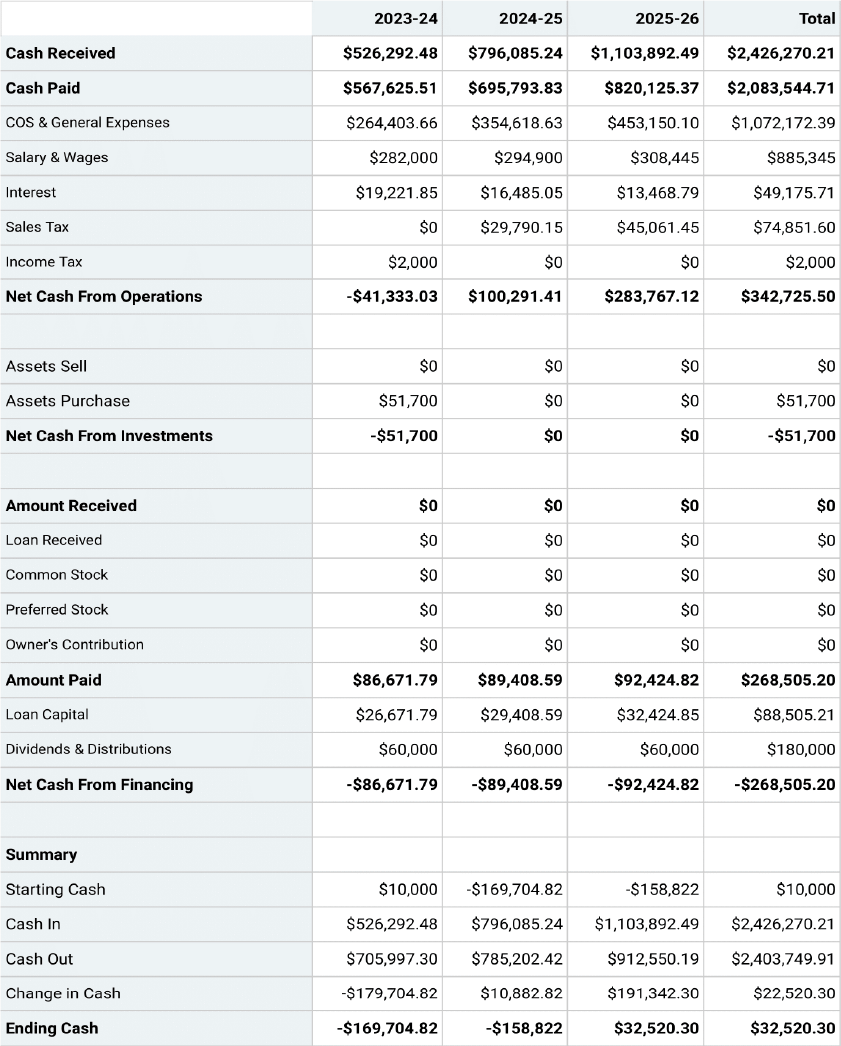
Projected Profit & Loss Statement

Break Even Analysis

Start Preparing Your Financial Plan
We covered everything about financial planning in this guide, didn’t we? Although it doesn’t fulfill our objective to the fullest—we want you to finish your financial plan.
Sounds like a tough job? We have an easy way out for you—Upmetrics’ financial forecasting feature. Simply enter your financial assumptions, and let it do the rest.
So what are you waiting for? Try Upmetrics and create your financial plan in a snap.
Build your Business Plan Faster
with step-by-step Guidance & AI Assistance.

Frequently Asked Questions
How often should i update my financial projections.
Well, there is no particular rule about it. However, reviewing and updating your financial plan once a year is considered an ideal practice as it ensures that the financial aspirations you started and the projections you made are still relevant.
How do I estimate startup costs accurately?
You can estimate your startup costs by identifying and factoring various one-time, recurring, and hidden expenses. However, using a financial forecasting tool like Upmetrics will ensure accurate costs while speeding up the process.
What financial ratios should startups pay attention to?
Here’s a list of financial ratios every startup owner should keep an eye on:
- Net profit margin
- Current ratio
- Quick ratio
- Working capital
- Return on equity
- Debt-to-equity ratio
- Return on assets
- Debt-to-asset ratio
What are the 3 different scenarios in scenario analysis?
As discussed earlier, Scenario analysis is the process of ascertaining and analyzing possible events that can occur in the future. Startups or small businesses often consider analyzing these three scenarios:
- base-case (expected) scenario
- Worst-case scenario
- best case scenario.
About the Author

Ajay is the Head of Content at Upmetrics. Before joining our team, he was a personal finance blogger and SaaS writer, covering topics such as startups, budgeting, and credit cards. If not writing, he’s probably having a power nap. Read more
Get started with Upmetrics Al
- 400+ sample business plans
- Al-powered financial planning
- Collaborative workspace
Reach Your Goals with Accurate Planning


How to Write the Financial Section of a Business Plan
T he financial section is the backbone of any business plan, offering insights into the viability of your business idea. It’s often the first section scrutinized by potential investors. This segment includes four essential financial statements: the income statement, cash flow projection, balance sheet, and statement of shareholders' equity. Alongside these, an explanatory analysis provides clarity and context.
Categorizing Your Expenses
Begin by categorizing your expenses into two primary groups: start-up expenses and operating expenses .
Start-Up Expenses
These cover all initial costs to launch your business, including but not limited to:
- Business registration fees
- Licenses and permits
- Initial inventory
- Rent deposits
- Down payments for property or equipment
- Utility setup charges
Each business's list may vary depending on the industry, so take the time to itemize thoroughly.
Operating Expenses
Operating expenses represent the recurring monthly costs required to sustain your business. Common examples include:
- Salaries, including your own
- Rent or mortgage payments
- Utilities and telecommunication expenses
- Raw materials and supplies
- Distribution and storage costs
- Marketing and promotions
- Loan repayments
- Office supplies and maintenance
Once itemized, calculate the total monthly operating expenses. Multiply this by six to estimate a six-month financial buffer. Adding this figure to your start-up costs will give you a ballpark total of your initial financial requirements.
Building the Financial Statements
Once you’ve outlined your expenses, it’s time to craft your financial statements.
1. The Income Statement
The income statement offers a snapshot of your business’s profitability by detailing revenues, expenses, and net profit for a specific period. The formula is simple:
Revenue - Expenses = Profit (or Loss)
For your business plan, generate monthly income statements for the first year. Established businesses typically create these statements quarterly or annually, but a monthly breakdown is essential for start-ups to track progress closely.
Customize your income statement to fit your business. For product-based businesses, revenue should reflect sales figures, and inventory must be accounted for.
2. The Cash Flow Projection
The cash flow projection forecasts the inflow and outflow of cash in your business, helping you manage finances effectively. It’s a critical tool for identifying potential cash shortages or surplus.
Investors closely examine this projection to determine your business’s creditworthiness and funding needs. Include monthly projections for the first year as part of your financial plan.
Key Components of Cash Flow Projection:
- Cash Revenues: Enter estimated monthly sales collectible in cash.
- Cash Disbursements: Include all expected cash expenditures based on your operating expenses.
- Reconciliation: Calculate the month-end balance by adding opening balances and revenues, then subtracting disbursements.
Distinction:
Do not confuse the cash flow projection with the cash flow statement. The projection forecasts future cash activity, while the statement reflects past cash movement.
3. The Balance Sheet
The balance sheet provides a comprehensive view of your business's financial standing at a specific moment. It summarizes:
- Assets: Tangible or intangible items of value owned by the business.
- Liabilities: Outstanding debts or obligations.
- Equity: The net worth of the business, calculated as Assets - Liabilities.
For your business plan, prepare a pro forma balance sheet to present projected financial data based on your income statement and cash flow projections. Typically, businesses create balance sheets annually, but you should include a one-year forecast for planning purposes.
Additional Considerations
Customization.
Every business is unique, and so are its financial needs. Tailor your financial statements and projections to reflect the specific nature of your business, ensuring they provide accurate and relevant data.
Investor Expectations
Investors expect transparency and precision. Your financial section should clearly demonstrate your business’s profitability potential, funding requirements, and long-term financial health.
Tools and Resources
Utilize financial templates for accuracy and consistency. Many online resources provide customizable templates for income statements, cash flow projections, and balance sheets.
Final Thoughts
The financial section of your business plan is more than just numbers; it’s a detailed map of your business’s financial journey. By carefully crafting each statement and providing thorough explanations, you not only ensure clarity for yourself but also instill confidence in potential investors.
Take the time to get your numbers right, tailor your projections, and present a realistic yet compelling case for your business’s financial success.

🎧 Real entrepreneurs. Real stories.
Subscribe to The Hurdle podcast today!
How to Write a Financial Plan for a Business Plan

Noah Parsons
4 min. read
Updated July 11, 2024

Creating a financial plan for a business plan is often the most intimidating part for small business owners.
It’s also one of the most vital. Businesses with well-structured and accurate financial statements are more prepared to pitch to investors, receive funding, and achieve long-term success.
Thankfully, you don’t need an accounting degree to successfully create your budget and forecasts.
Here is everything you need to include in your business plan’s financial plan, along with optional performance metrics, funding specifics, mistakes to avoid , and free templates.
- Key components of a financial plan in business plans
A sound financial plan for a business plan is made up of six key components that help you easily track and forecast your business financials. They include your:
Sales forecast
What do you expect to sell in a given period? Segment and organize your sales projections with a personalized sales forecast based on your business type.
Subscription sales forecast
While not too different from traditional sales forecasts—there are a few specific terms and calculations you’ll need to know when forecasting sales for a subscription-based business.
Expense budget
Create, review, and revise your expense budget to keep your business on track and more easily predict future expenses.
How to forecast personnel costs
How much do your current, and future, employees’ pay, taxes, and benefits cost your business? Find out by forecasting your personnel costs.
Profit and loss forecast
Track how you make money and how much you spend by listing all of your revenue streams and expenses in your profit and loss statement.
Cash flow forecast
Manage and create projections for the inflow and outflow of cash by building a cash flow statement and forecast.
Balance sheet
Need a snapshot of your business’s financial position? Keep an eye on your assets, liabilities, and equity within the balance sheet.
What to include if you plan to pursue funding
Do you plan to pursue any form of funding or financing? If the answer is yes, you’ll need to include a few additional pieces of information as part of your business plan’s financial plan example.
Highlight any risks and assumptions
Every entrepreneur takes risks with the biggest being assumptions and guesses about the future. Just be sure to track and address these unknowns in your plan early on.
Plan your exit strategy
Investors will want to know your long-term plans as a business owner. While you don’t need to have all the details, it’s worth taking the time to think through how you eventually plan to leave your business.
- Financial ratios and metrics
With your financial statements and forecasts in place, you have all the numbers needed to calculate insightful financial ratios.
While including these metrics in your financial plan for a business plan is entirely optional, having them easily accessible can be valuable for tracking your performance and overall financial situation.
Key financial terms you should know
It’s not hard. Anybody who can run a business can understand these key financial terms. And every business owner and entrepreneur should know them.
Common business ratios
Unsure of which business ratios you should be using? Check out this list of key financial ratios that bankers, financial analysts, and investors will want to see.
Break-even analysis
Do you want to know when you’ll become profitable? Find out how much you need to sell to offset your production costs by conducting a break-even analysis.
How to calculate ROI
How much could a business decision be worth? Evaluate the efficiency or profitability by calculating the potential return on investment (ROI).
- How to improve your financial plan
Your financial statements are the core part of your business plan’s financial plan that you’ll revisit most often. Instead of worrying about getting it perfect the first time, check out the following resources to learn how to improve your projections over time.
Common mistakes with business forecasts
I was glad to be asked about common mistakes with startup financial projections. I read about 100 business plans per year, and I have this list of mistakes.
How to improve your financial projections
Learn how to improve your business financial projections by following these five basic guidelines.
Brought to you by
Create a professional business plan
Using ai and step-by-step instructions.
Secure funding
Validate ideas
Build a strategy
- Financial plan templates and tools
Download and use these free financial templates and calculators to easily create your own financial plan.

Sales forecast template
Download a free detailed sales forecast spreadsheet, with built-in formulas, to easily estimate your first full year of monthly sales.
Download Template

Accurate and easy financial forecasting
Get a full financial picture of your business with LivePlan's simple financial management tools.
Get Started
Noah is the COO at Palo Alto Software, makers of the online business plan app LivePlan. He started his career at Yahoo! and then helped start the user review site Epinions.com. From there he started a software distribution business in the UK before coming to Palo Alto Software to run the marketing and product teams.

Table of Contents
- What to include for funding
Related Articles

10 Min. Read
How to Write a Competitive Analysis for Your Business Plan

How to Set and Use Milestones in Your Business Plan

6 Min. Read
How to Write Your Business Plan Cover Page + Template

How to Write the Company Overview for a Business Plan
The LivePlan Newsletter
Become a smarter, more strategic entrepreneur.
Your first monthly newsetter will be delivered soon..
Unsubscribe anytime. Privacy policy .

The quickest way to turn a business idea into a business plan
Fill-in-the-blanks and automatic financials make it easy.
No thanks, I prefer writing 40-page documents.

Discover the world’s #1 plan building software
Everything that you need to know to start your own business. From business ideas to researching the competition.
Practical and real-world advice on how to run your business — from managing employees to keeping the books
Our best expert advice on how to grow your business — from attracting new customers to keeping existing customers happy and having the capital to do it.
Entrepreneurs and industry leaders share their best advice on how to take your company to the next level.
- Business Ideas
- Human Resources
- Business Financing
- Growth Studio
- Ask the Board
Looking for your local chamber?
Interested in partnering with us?
Start » startup, business plan financials: 3 statements to include.
The finance section of your business plan is essential to securing investors and determining whether your idea is even viable. Here's what to include.

If your business plan is the blueprint of how to run your company, the financials section is the key to making it happen. The finance section of your business plan is essential to determining whether your idea is even viable in the long term. It’s also necessary to convince investors of this viability and subsequently secure the type and amount of funding you need. Here’s what to include in your business plan financials.
[Read: How to Write a One-Page Business Plan ]
What are business plan financials?
Business plan financials is the section of your business plan that outlines your past, current and projected financial state. This section includes all the numbers and hard data you’ll need to plan for your business’s future, and to make your case to potential investors. You will need to include supporting financial documents and any funding requests in this part of your business plan.
Business plan financials are vital because they allow you to budget for existing or future expenses, as well as forecast your business’s future finances. A strongly written finance section also helps you obtain necessary funding from investors, allowing you to grow your business.
Sections to include in your business plan financials
Here are the three statements to include in the finance section of your business plan:
Profit and loss statement
A profit and loss statement , also known as an income statement, identifies your business’s revenue (profit) and expenses (loss). This document describes your company’s overall financial health in a given time period. While profit and loss statements are typically prepared quarterly, you will need to do so at least annually before filing your business tax return with the IRS.
Common items to include on a profit and loss statement :
- Revenue: total sales and refunds, including any money gained from selling property or equipment.
- Expenditures: total expenses.
- Cost of goods sold (COGS): the cost of making products, including materials and time.
- Gross margin: revenue minus COGS.
- Operational expenditures (OPEX): the cost of running your business, including paying employees, rent, equipment and travel expenses.
- Depreciation: any loss of value over time, such as with equipment.
- Earnings before tax (EBT): revenue minus COGS, OPEX, interest, loan payments and depreciation.
- Profit: revenue minus all of your expenses.
Businesses that have not yet started should provide projected income statements in their financials section. Currently operational businesses should include past and present income statements, in addition to any future projections.
[Read: Top Small Business Planning Strategies ]
A strongly written finance section also helps you obtain necessary funding from investors, allowing you to grow your business.
Balance sheet
A balance sheet provides a snapshot of your company’s finances, allowing you to keep track of earnings and expenses. It includes what your business owns (assets) versus what it owes (liabilities), as well as how much your business is currently worth (equity).
On the assets side of your balance sheet, you will have three subsections: current assets, fixed assets and other assets. Current assets include cash or its equivalent value, while fixed assets refer to long-term investments like equipment or buildings. Any assets that do not fall within these categories, such as patents and copyrights, can be classified as other assets.
On the liabilities side of your balance sheet, include a total of what your business owes. These can be broken down into two parts: current liabilities (amounts to be paid within a year) and long-term liabilities (amounts due for longer than a year, including mortgages and employee benefits).
Once you’ve calculated your assets and liabilities, you can determine your business’s net worth, also known as equity. This can be calculated by subtracting what you owe from what you own, or assets minus liabilities.
Cash flow statement
A cash flow statement shows the exact amount of money coming into your business (inflow) and going out of it (outflow). Each cost incurred or amount earned should be documented on its own line, and categorized into one of the following three categories: operating activities, investment activities and financing activities. These three categories can all have inflow and outflow activities.
Operating activities involve any ongoing expenses necessary for day-to-day operations; these are likely to make up the majority of your cash flow statement. Investment activities, on the other hand, cover any long-term payments that are needed to start and run your business. Finally, financing activities include the money you’ve used to fund your business venture, including transactions with creditors or funders.
CO— aims to bring you inspiration from leading respected experts. However, before making any business decision, you should consult a professional who can advise you based on your individual situation.
Follow us on Instagram for more expert tips & business owners’ stories.
CO—is committed to helping you start, run and grow your small business. Learn more about the benefits of small business membership in the U.S. Chamber of Commerce, here .
Subscribe to our newsletter, Midnight Oil
Expert business advice, news, and trends, delivered weekly
By signing up you agree to the CO— Privacy Policy. You can opt out anytime.
More tips for your startup
How to start a contracting business, how to use ai tools to write a business plan, writing a business plan here's how to do it, section by section.
By continuing on our website, you agree to our use of cookies for statistical and personalisation purposes. Know More
Welcome to CO—
Designed for business owners, CO— is a site that connects like minds and delivers actionable insights for next-level growth.
U.S. Chamber of Commerce 1615 H Street, NW Washington, DC 20062
Social links
Looking for local chamber, stay in touch.

IMAGES
COMMENTS
If you are using your business plan to attract investment or get a loan, you may also include a business financial history as part of the financial section. This is a summary of your business from ...
As part of your business plan, the cash flow projection will show how much capital investment your business idea needs. For investors, the cash flow projection shows whether your business is a good credit risk and if there is enough cash on hand to make your business a good candidate for a line of credit, a short-term loan , or a longer-term ...
The financial part of the business plan introduces numbers. It comes after the executive summary, company description, market analysis, organization structure, product information, and marketing and sales strategies. Businesses that are trying to get financing from lenders or investors use the financial section to make their case. This section ...
What is a financial plan in a business plan? A financial plan is a key part of a business plan. It shows the money side of a business idea. This plan helps owners and investors see if the business can make money. Executive summary of a financial plan. A financial plan has several important parts.
A good business plan is an entrepreneur's best friend. ... • Financial history: Summary of your business finances from the start of operations to the present time ... Don't forget this part ...
Use this financial plan template to organize and prepare the financial section of your business plan. This customizable template has room to provide a financial overview, any important assumptions, key financial indicators and ratios, a break-even analysis, and pro forma financial statements to share key financial data with potential investors.
A business plan's financial plan section is no easy task—we get that. ... Startup financial planning, in simple terms, is a process of planning the financial aspects of a new business. It's an integral part of a business plan and comprises its three major components: balance sheet, income statement, and cash-flow statement. ...
For your business plan, prepare a pro forma balance sheet to present projected financial data based on your income statement and cash flow projections. Typically, businesses create balance sheets ...
Creating a financial plan for a business plan is often the most intimidating part for small business owners. It's also one of the most vital. Businesses with well-structured and accurate financial statements are more prepared to pitch to investors, receive funding, and achieve long-term success.
You will need to include supporting financial documents and any funding requests in this part of your business plan. Business plan financials are vital because they allow you to budget for existing or future expenses, as well as forecast your business's future finances. A strongly written finance section also helps you obtain necessary ...